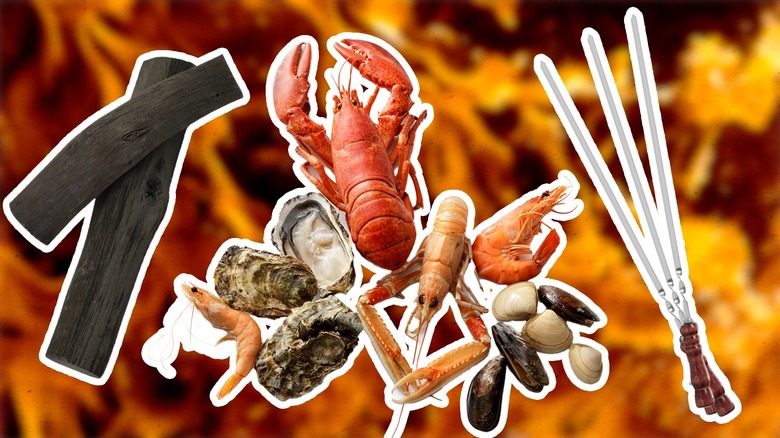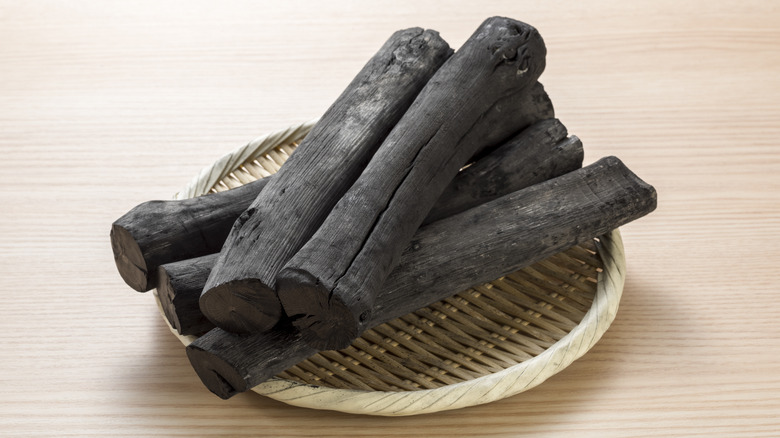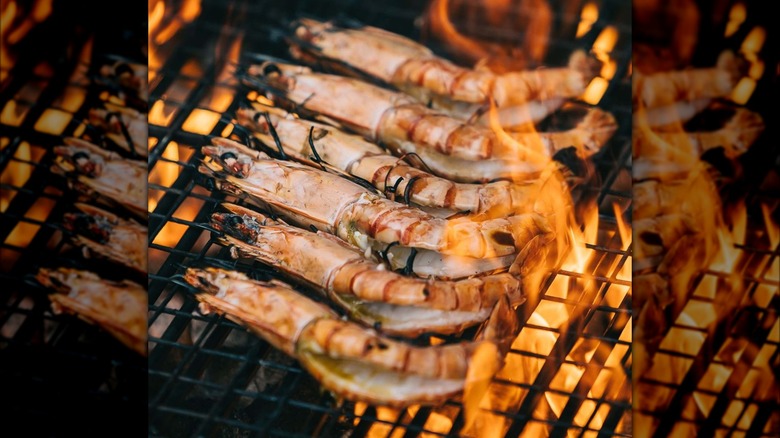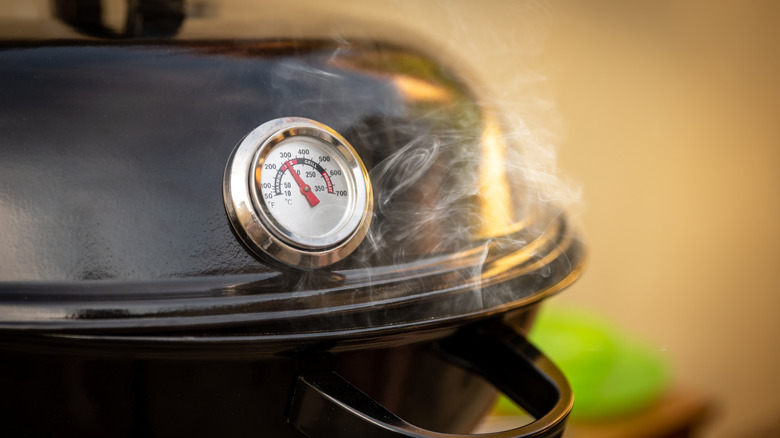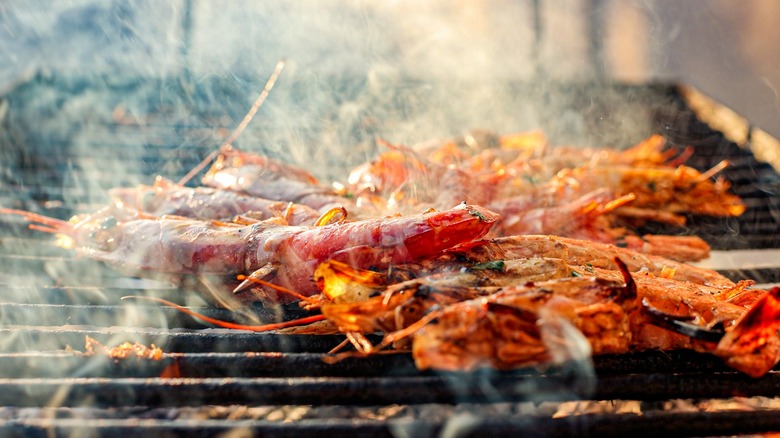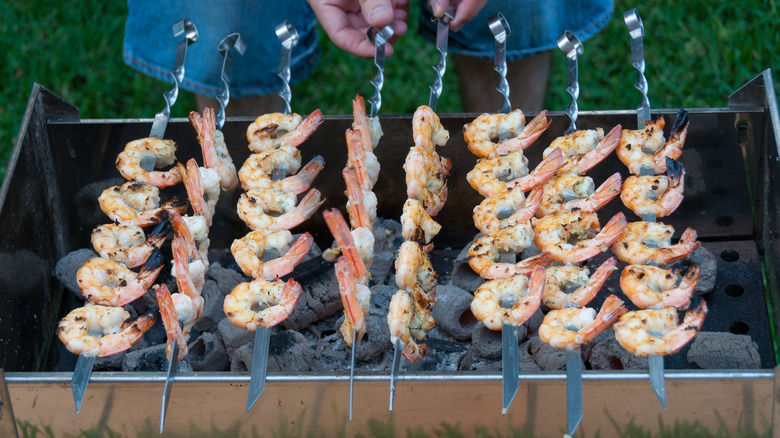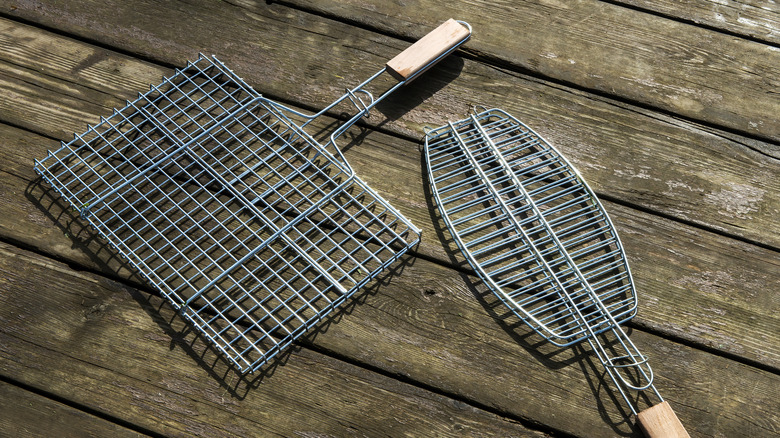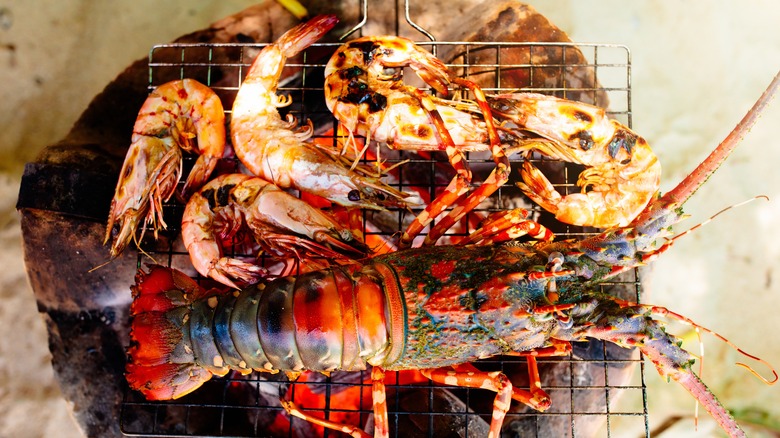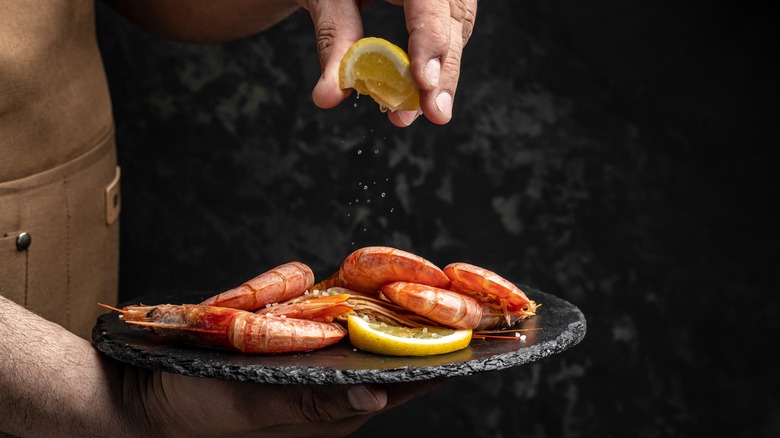8 Tips For Grilling Shellfish According To A Michelin-Star Chef
Nothing beats cooking outside. The wind in your hair, a beer in your hand, and an open flame at the ready ... if you love to cook, that's pretty much as good as it gets. Add a nice, thick steak or several chicken thighs and you're in heaven. But what if you want to turn that steak dinner into a little surf and turf? You could just run inside and prepare your shrimp or lobster on the stove while the beef is charring out back, but wouldn't it be better if both proteins were in the same spot? After all, you want to enjoy your cook (and that beer) — not spend the whole time running back-and-forth.
We know that grilling shellfish can be scary. Unlike chicken or steak, which can be pierced with a thermometer to determine its doneness, shellfish comes with a thick, hard shell that isn't as easy to penetrate. Then there's the question of where it should go on the grill and what kinds of tools you'll need. While we know a thing or two about grilling, when it comes to grilling shellfish, we draw a blank. Lucky for us, Michelin-starred chef, Peter Hemsley, grills shellfish all day long at his San Francisco restaurant, Aphotic. So, we asked him to share his top tips for grilling shellfish at home. That way, the next time we're craving a little surf and turf, we won't have to order out; we can do it right in our own backyard.
Japanese charcoal is the best charcoal to use when grilling shellfish
You may associate grilling with someone pouring a big bag of briquettes into the bowl, covering it with lighter fluid, and watching the blaze go sky-high with the strike of a single match. While it's still easy to run to the store and grab a bag of those briquettes, there are other types of charcoal that you should consider using instead. There other options can be made without chemicals and won't burn out way before your grilling is done. With so many different choices, which is the best for shellfish? Chef Peter Hemsely says it all "depends on what your budget is."
While he uses a mesquite charcoal from Mexico at the restaurant because it's cheaper and a great choice for constant grilling, the chef says, "if you have a larger budget and you're more of a higher-end culinary bent and want a more refined smoke and flavor profile, you'll opt for a Japanese charcoal." This highly sought after charcoal will not only burn longer, but it also has "a more refined flavor." Even though Hemsley says he'd be "remiss" to recommend a specific brand, the chef tells us that the most expensive brands will have the slowest burn rate. Therefore, these should be saved for your more expensive, higher-end shellfish.
Cook your shellfish over direct heat
If you're a big grill aficionado, you know that there are two zones of heat: direct and indirect. A lot of the time, we'll start our protein over direct heat to get a nice char on the outside, then we'll slide it over to the indirect zone to finish the cook. That way, the protein will get cooked all the way through without charring to a crisp. That may be all well and good for a thick steak or chicken thigh, but since shrimp and lobster don't need as much cooking time, Hemsley recommends using direct heat from beginning to end.
See, most shellfish have a smaller surface area and aren't nearly as thick as those steaks and chicken thighs, so they'll cook up quite quickly. If, however, there is a time when you want to smoke your shellfish, then the chef says indirect heat is the way to go. But he recommends saving the smoking for a nice, red-blooded fish. Since most shellfish cook quickly, they don't need to be smoked or shifted to the edge of the grill and into that indirect heat zone.
Your grill should be between 375 and 500 F
While you should always have a thermometer handy to make sure that your protein is the right temperature when it comes off the grill, you also want to make sure that your grill is at the right temperatures when you start cooking. Thankfully, these days most grills come with a thermometer built right in the cover so you know exactly how hot it is under the hood. The optimal temperature depends on what you're cooking. Hemsley says that if you're smoke cooking something, you should keep it at a "relatively low temperature." "But when you're dealing with shellfish," the chef explains, "you want to develop a really nice foundation of coals that's evenly dispersed a couple inches away from the grill line so you don't light your shellfish on fire if it's marinated in a fat like an oil."
While Hemsley admits that he can't recommend an exact temperature at which to cook the shellfish "because [he] works more visually with [his] eyes and the actual physical heat," he figures the temperature is somewhere between 375 and 500 F. In other words, it's hot enough to give your fish a good sear in a limited amount of time.
Don't leave shellfish on the grill for very long
Cooking times are an important factor for every dish from cakes to steaks. In a similar vein, each type of shellfish has a different recommended cooking time. A spiny lobster, for example, will take longer than a tiny spot prawn and will require a little more finesse since it's a larger shellfish. Hemsley says the best thing to do is use your senses to determine how much time your seafood needs to spend on the grill.
"Cooking is highly personalized and you need to be your own chef when you're cooking anything," he says. But the chef agrees that every item has an optimal cook time. If you're using store-bought shrimp, Hemsley says those will only take about "two minutes per side on the proper grill." But a lobster should only be over an open flame for five or 10 minutes. "Nothing stays on the grill on the shellfish frontier for very long," he continues. "It's really sort of the quintessential á la minute cooking item."
Metal skewers are a must for shrimp or prawns
Shrimp and prawns are at the small end of the shellfish spectrum, so they're harder to pick up and move on the grill. While you could throw a bunch on and use your tongs to flip each one individually, it's going to take a while and you'll probably end up with a pretty uneven cook at the end. That's why Hemsley tells us it's better to use skewers for this particular shellfish.
At Aphotic, Hemsley says he mainly uses long Japanese hibachi metal skewers. They're a great choice because they're reusable and you can fit a lot of shrimp or smaller fish on them. But because they're metal and metal is a wonderful heat conductor, Hemsley cautions working withthem. "They heat up too, so you want to stick them outside of the end of a grill optimally, so you're not picking them up with your bare hand and searing your hand," the chef explains. Wood, on the other hand, won't heat up as quickly, so Hemsely says it won't burn the fish or your hands. It's also a great tool if you're looking to serve the shrimp to your guests on the skewers.
Grill baskets are great when you have a large volume of shellfish to prepare
Skewers are a wonderful choice if you're grilling a few shellfish for the family. But on those occasions when you're making a big seafood feast for a lot of people, Hemsley says that the grill basket is the way to go. "The basket can be great, for example, if you want to do a little bit more volume like marinated shrimp and you don't want to sit there with tongs and kind of be delicately turning them over their side and whatever."
But since there's so much shrimp all piled on top of each other, the chef says it "might be a longer cooking affair." This is because depending on where the shrimp are in the pile, it might take longer for the flames to reach them. So, Hemsley says the best thing to do is put the shrimp in the basket and "just kind of let it sit and kind of jostle it" as needed. That way, the shrimp will shift around inside and get a more even cook all around. If you're unsure of which basket to get, Hemsley suggests Made In, the company they use at his restaurant. "They have some really great carbon steel items that are grill ready," he says.
Lobster and shrimp are the easiest shellfish to grill
With so many different kinds of shellfish available, it's hard to know which one will be the best on the barbecue. And let's face it: Some species are just better suited for the oven and stovetop. But since we love our grill and will put any protein we can on it, we had to know which shellfish the chef would recommend. "I mean shrimp and lobster are going to be the easiest and probably most bang for your buck in terms of excitement and level of anticipation when people are putting them on and just access to it," he says. But he goes on to tell us that other crustaceans "can be really fun" as well. It just depends on how comfortable you are with your grilling ability.
Oysters and clams, for instance, can be put on the grill and cooked in their own juices. But crab is a little more complicated because Hemsley says that it runs "the risk of sticking to its shell." If you're really jonesing for crab though, Hemsley suggests smoking it because the intense heat from the steam will make the flesh easier to remove from the shell. But "if you're not averse to peeling Dungeness crab off of the interior shell after it's cracked and getting your hands dirty," he continues, "it can be a fun way to do it. But it's not the cleanest."
Save the seasoning and marinades until the end
While we've all been told that it's best to season proteins a good 15 to 30 minutes before cook time, that's not the case with shellfish. Since most of these creatures are grilled in their shells, the seasoning won't penetrate the flesh — which is why you should wait until the end of the cook time before you start sprinkling your essential spices, like salt and pepper, over the dish. For something like lobster though, Hemsley says you could split the tails in half and drizzle a marinade over the open flesh while it's cooking. That way "[the lobster's] flesh is exposed and the marinade will penetrate" it.
He doesn't recommend that for shrimp, though, because they're far too small. Instead, the chef suggests peeling them, skewering them, and pre-marinating them. "Then after it's grilled, brush it with more of the marinade or place it into the marinade so it sucks up a lot of that post-cooking."
In case you're wondering which spices the Michelin-star chef favors, he says he likes to keep it simple. "I like salt, olive oil, and typically just a little bit of hot pepper and garlic ... [Then] finish off with lemon juice after, not before," he emphasizes. Drizzling lemon juice over the fish beforehand will cause the fish to start cooking before it ever hits the grill. In that case, you've got ceviche — which, while a great summer dish, is another story entirely.
